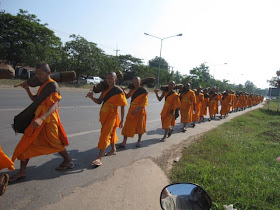Journey to Luang Mam Tha.
Joma Bakery Cafe on central Chanta Street. -a tourist hangout, great coffee and yogurt.
Just now a young handicapped man walking on hands and dragging his feet came to my table and just looked up at me. It was hard to look at him directly. What to do? Fortunately, my breakfast was fruit and yogurt
so I bundled up some bite size chunks of fruit into a napkin and offered it to him. He looked me in the eyes, lifted his dirty walking hands to show me how dirty they were. So I slowly put the pieces of fruit in his mouth which he quickly ate, then thanked me. My heart broke thinking about the way he had to live.
We are on the Lao Airline to Luang Nam Tha pop. 35,000, next to China-Burma border for 5 days. Two features of this province: Nam Ha National Protected Area ( 2224-sq-km area) densely forested regions (96%primary forest cover) in Laos and many ethnic villages which include Hmong, Akha, Mien, Santao, Thai Daeng, Thai Lu, Thai Nuea, Thai Kalom, Khamu, Lamet, Lao Loum, Shan and Yunnanese.
The plane trip was highlighted with the conversations with to vibrant Madrid residents - Francisco is a photographer for a Newspaper and covers the world hot spots, Alexandra works in the photography collection department.
Just checked into our guest house, Thoulasith-$15 no air con or breakfast. Beautiful village with palm trees, rice paddies, wooden houses on stilts and a very quiet commercial center. There are many restaurants with extensive western and local restaurants. We are eating next door to our guest house at the Minority Restaurant -bamboo shoots soup and sweet and sour chicken with vegetables and rice.
Guest houses are everywhere to accommodate the young active travelers who will kayak, trek and explore in this paradise.
We're making plans for a days journey tomorrow to visit some of the ethic villages close by. What will we see? The night market with weaving here turned out to be a huge disappointment. Too bad
A bicycle ride around town and then some yogurt smoothies followed by an herbal sauna in one of those wooden houses on stilts with bamboo flooring. We declined the massage because there were several others waiting for their turn. Quite an experience. Very few people here speak English.
We met a German man who had biked in from Tajikistan. He said his favorite part of the trip was in Tibet due to the uniqueness of the people and their kindness .
Enough for today. Sleep dear sleep.
Hotel in Muang Sing. Phot Ii Bungalow 020 55686909-086-400012
 Studying the guidebook, I decide a loose itinerary for the journey and keep refining it as the days pass.
Studying the guidebook, I decide a loose itinerary for the journey and keep refining it as the days pass. by Paul and Elaine Lewis.
by Paul and Elaine Lewis. 























